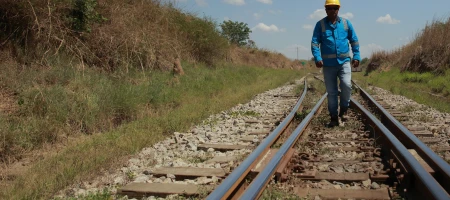
Challenges for a just transition in Colombia
The coal market has undergone several changes in recent years and its instability has major impact on the coal mining regions of northern Colombia. As the worldwide decarbonization process continues, it is expected the region’s communities will face mayor challenges. Scenarios for a just transition need to be developed to face an eventual economic and social crisis.
Coal mining has been an important source of income for thousands of families for decades. It still represents an important economic sector. However, at the same time it has had negative effects on workers, communities and the environment in the region; the presence of multinationals has also been controversial.
Glencore
In recent months, the Colombian coal production chain have had to face new challenges that have led to massive lay-offs, mine closures and operational displacements. Mining multinational Glencore decided to withdraw from the mining region Cesar in the north of Colombia. The multinational returned its mining titles in La Guajira (Cesar) without an adequate and responsible reparation of the environment and the affected communities.
Glencore is one of the companies that has used this kind of strategy, claiming to have to do so because of the falling coal prices and its instability.
Colombian government
The national government’s lack of effort of a just transition approach further reinforced the population’s discomfort. Workers were left behind without any perspective after the mine closed.
A coal market global perspective
Recently, coal markets have been able to recover because the conflict in Ukraine. However, although there is an increase in demand for coal, there still is a need to establish strategies to deal with future developments related to the current climate crisis. In the context of the energy transition, it is crucial to develop a social justice approach.
Due to a growing concern about climate change, Europe and the United States have decided to initiate a decarbonization and energy transition process. This scenario, in turn, will affect the coal market in the long term. As did the COVID-19 pandemic: the demand for coal by large industrial sectors dropped significantly. However, since 2021, slowly the demand for coal is growing again, which has increased even more because of the war in Ukraine.
Short term
The International Energy Agency (IEA) has analyzed possible future short- and long-term scenarios for coal. According to their analysis, in the short term, although the Western powers are gradually implementing a transition to renewable energies, the demand and production nevertheless will continue to increase. This is because some Asian countries have actually increased their consumption of coal and in Europe, as was mentioned before, the war in Ukraine has had a positive effect on the need for coal.
4 Long-term scenarios
In the long run, the IEA sketches four possible scenarios:
- First scenario: the coal economy will return to the same production level as it was before the pandemic.
- Second scenario: the coal economy will take a little longer to stabilize and by 2023, it will reach pre-pandemic numbers.
- Third scenario: despite the fact that in Asia the production and consumption of coal is moderately increasing, the fall in numbers in the United States and Europe will cause coal production to remain stable in 2030. It will begin to decrease during the next decade.
Fourth scenario: (the least encouraging scenario for this sector), in the next 20 years, Asia reduces its coal production and consumption, while simultaneously the United States and Europe accelerates their transition to renewable energy. In this case, global consumption will fall by 30% in 2030.
The European Green Deal
Following the Paris Agreement, several initiatives have been deployed to address climate change commitments in Europe and the United States. The European Union has taken seriously the need to decarbonize its energy matrix, and it is through the European Green Deal that it has sought to generate guidelines for its member countries to carry out the necessary measures to meet the proposed goals.
European energy matrix
With the goal of reducing greenhouse gasses by at least 55% by 2030, a series of mechanisms have been proposed in the European Green Deal that address all the fields necessary to meet the objective, including the European energy matrix. It has an ambitious budget, with which it is expected to curb climate change and make the European economy more efficient and competitive.
Just transition perspective
In this context, roadmaps have been developed that have to be accepted by its member countries and translated into national plans. Some of these plans are already being implemented; in countries such as Spain and the Netherlands, transition plans were implemented in the 1960s. It is of course evident that these decarbonization plans are urgent plans. Their positive results are due, in large part, to the implementation of a just transition perspective, which has been accompanied by the unions in each of the countries.
COP26
On the other hand, the Conference of the Parties (COP26) held at the end of 2021, sought to generate new commitments with the participating countries to curb climate change at a global level. One of the most important advances of COP26 has been the declaration of just transition, which was adopted by 14 countries and the European Commission. In this declaration, in addition to committing to carry out a just transition in their own countries, they highlighted their commitments to decarbonization efforts in poorer countries, through financing, based on the principles of a just transition.
Leaving no one behind
This declaration was an achievement of the trade union movement. It promoted the discussion in global bodies such as the UN, requesting that decarbonization, which was already on the international agenda, would not leave anyone behind. The initiative bore its first fruits by ensuring that the just energy transition in South Africa was financially supported by the member countries.
Adaptation challenges in Colombia
Colombia has not considered an energy transition that decisively strikes the production and consumption of coal, given the international scenario presented. Nevertheless, the country is still facing an adaptation challenge in a possible coal crisis. Contradictorily, during the COP26 in Glasgow, the current president Iván Duque promised to reduce greenhouse gas emissions by 51% by the year 2030 and to be a carbon-neutral country by the year 2050. But the new public CONPES (National Council for Economic and Social Policy) document includes the carbon economy in energy transition plans.
Emergency
The analysis carried out by the Regional Centre for Responsible Companies and Entrepreneurship (CREER) highlights the state of emergency of the coal economy and the consequences that it could cause for Colombian society, due to its high dependence on this economic sector.
Global demand
According to CREER, the country's adaptation challenge is determined by the global demand for coal, due to the limited export supply in Colombia and the country's fiscal situation. Problems such as the high levels of poverty in coal regions, the difficulty of generating alternative economies that can replace the jobs that the coal economy would leave, and the dependence on royalties from this industry, would further increase the challenges for the country.
Asian markets
Colombia could decide to focus on the Asian markets, because these would be the only market that would maintain or increase its coal consumption. Nevertheless, in that case, due to high transportation costs and lack of investment in the future of this economy, the government would have to implement unfavourable measures; it would have to sacrifice part of the royalties obtained from coal and carry. These reforms would discourage investors in the mining sector, which would cause a reduction of mining expenses, hence, generating great social and environmental consequences.
- CREER determined that the specific impacts for Colombia would be:
- an increase in unemployment,
- an increase in informal work,
- the need for social protection programs as solutions to social problems,
- an decrease in royalties that comes with the decrease in investment in development and social programs,
- an increase in social conflict, and
- large environmental liabilities.
In sum, the country's dependence on coal and the structural insufficiency for an eventual transition implies that, without adequate measures and the necessary budget, Colombia would face a possible social, economic and environmental crisis in the context of international decarbonization.
The just transition in the face of uncertainty
After analysing the possible impacts, CREER offered a series of recommendations that can become guidelines for the formulation of a life-saving policy in Colombia in the face of a possible crisis caused by the collapse of the coal market. They highlight the need to implement a just transition plan based on learning from the experiences of other countries and the importance of it being agreed upon by the different actors involved.
The contribution of developed countries
In addition, it highlights the important role that coal purchasing countries have in this task, since, as highlighted in the declaration on just transition at COP26, “developed” countries must contribute to the implementation of the just transition in countries such as Colombia, since as producers they depend of this economy that is sought to be abandoned. They are the ones who will be most affected.
Social Protection Fund
On the other hand, the national government and the mining companies must also assume their responsibilities to formulate and implement an energy transition hand in hand with the unions and affected communities. Therefore, the call is to agree on a just transition at the national and international level, capable of facing future scenarios of the coal economy, taking into account the boom in its prices and the arrival of dollars to the country as a consequence. These resources should be used for a Social Protection Fund for the communities most affected when the economic activity of coal would disappear due to the decarbonization.
